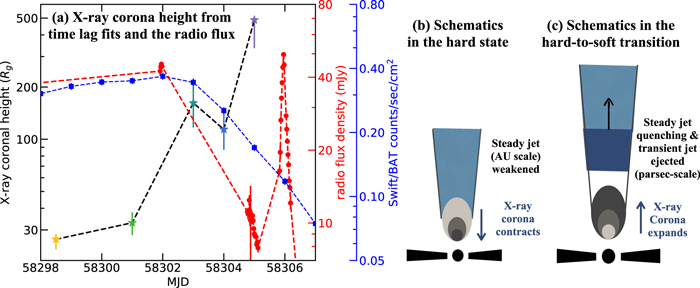NICER / ISS Science Nugget
for July 8, 2021
NICER Connects the Dots in Accretion States of Black Hole Binaries
X-rays emitted by binary systems that comprise a black hole (BH) and a companion star typically have three components:
- thermal radiation from a hot disk of matter drawn from the companion and accreting onto the BH;
- non-thermal radiation from an ultra-hot plasma dubbed the "corona" that lies near and above the BH but with uncertain shape and origin; and
- X-rays from the corona that are reflected by the accretion disk.
In addition to X-rays, such systems are also known to produce radio emission associated with a jet of fast-moving particles emitted at right angles to the disk (see figure below right). The typical quiescent state of low-level accretion in such systems is punctuated every few years by a bright X-ray outburst that lasts for several weeks, following an established pattern of high-energy X-ray emission (the "hard" state dominated by the corona) transitioning to low-energy X-ray emission (the "soft" state dominated by the disk) through an "intermediate" state. The relatively nearby BH binary MAXI J1820+070 was discovered during such an outburst in 2018 and was monitored intensively by NICER.
Following up on earlier work that investigated the hard state of MAXI J1820 (Kara et al. 2019; Nature, Vol. 565, p. 198), a team led by MIT graduate student Jingyi Wang recently published (Astrophysical Journal Letters, Vol. 910, p. L3) an analysis of NICER data during the hard-to-soft state transition, demonstrating the expansion of the corona and its near-coincidence in time with the launch of a fast radio jet. The measurements tracked rapid fluctuations - frequencies of a few Hz - in the brightness of the corona at high X-ray energies and how those fluctuations were reflected in the low-energy emission of the disk. Delays introduced by the time it took the coronal light to travel to the disk were found to increase through the intermediate state, strongly suggesting that the corona was expanding while it dimmed (see figure panel (a)). Meanwhile, radio observations showed that the steady and already-weak jet dimmed further until suddenly brightening at the end of the coronal expansion, as a knot of relativistic plasma was ejected by the BH.
In addition to its peer-reviewed publication, this work was highlighted this week in a brief article in the American Astronomical Society's NOVA newsletter.

Figure: Evidence for a temporal relationship between the size of an X-ray corona and an evolving radio jet in the black-hole binary MAXI J1820+070. (a) The black dashed line and star-shaped points chart changes over time (in Modified Julian Day, MJD) to the delay in X-ray emission from the corona as reflected by the accretion disk, from NICER spectral-timing measurements, demonstrating longer delays and thus increasing height of the corona (measured in units of the so-called gravitational radius of the black hole, Rg). In red is shown the evolution of radio brightness from the Arcminute Microkelvin Imager (U.K.); the high-energy X-ray brightness, from the Burst Alert Telescope (BAT) onboard NASA's Swift observatory is shown in blue. Vertical axes are on a logarithmic scale. (b) In the hard state, the jet is steady but weak, while the corona contracts. (c) In the hard-to-soft state transition, a transient and relativistic knot of plasma is launched along the jet axis soon after the X-ray corona expands.
<< Previous
Main Index